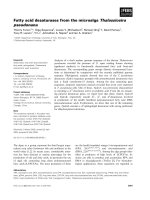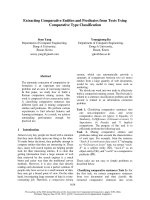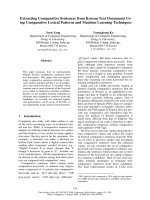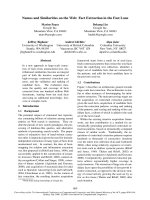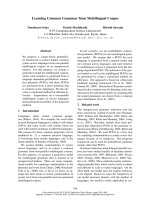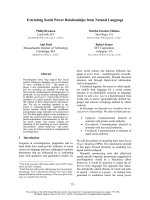Báo cáo khoa học: "Extracting Hypernym Pairs from the Web" potx
Bạn đang xem bản rút gọn của tài liệu. Xem và tải ngay bản đầy đủ của tài liệu tại đây (108.19 KB, 4 trang )
Proceedings of the ACL 2007 Demo and Poster Sessions, pages 165–168,
Prague, June 2007.
c
2007 Association for Computational Linguistics
Extracting Hypernym Pairs from the Web
Erik Tjong Kim Sang
ISLA, Informatics Institute
University of Amsterdam
Abstract
We apply pattern-based methods for collect-
ing hypernym relations from the web. We
compare our approach with hypernym ex-
traction from morphological clues and from
large text corpora. We show that the abun-
dance of available data on the web enables
obtaining good results with relatively unso-
phisticated techniques.
1 Introduction
WordNet is a key lexical resource for natural lan-
guage applications. However its coverage (currently
155k synsets for the English WordNet 2.0) is far
from complete. For languages other than English,
the available WordNets are considerably smaller,
like for Dutch with a 44k synset WordNet. Here, the
lack of coverage creates bigger problems. A man-
ual extension of the WordNets is costly. Currently,
there is a lot of interest in automatic techniques for
updating and extending taxonomies like WordNet.
Hearst (1992) was the first to apply fixed syn-
tactic patterns like such NP as NP for extracting
hypernym-hyponym pairs. Carballo (1999) built
noun hierarchies from evidence collected from con-
junctions. Pantel, Ravichandran and Hovy (2004)
learned syntactic patterns for identifying hypernym
relations and combined these with clusters built
from co-occurrence information. Recently, Snow,
Jurafsky and Ng (2005) generated tens of thousands
of hypernym patterns and combined these with noun
clusters to generate high-precision suggestions for
unknown noun insertion into WordNet (Snow et al.,
2006). The previously mentioned papers deal with
English. Little work has been done for other lan-
guages. IJzereef (2004) used fixed patterns to ex-
tract Dutch hypernyms from text and encyclopedias.
Van der Plas and Bouma (2005) employed noun dis-
tribution characteristics for extending the Dutch part
of EuroWordNet.
In earlier work, different techniques have been ap-
plied to large and very large text corpora. Today,
the web contains more data than the largest available
text corpus. For this reason, we are interested in em-
ploying the web for the extraction of hypernym re-
lations. We are especially curious about whether the
size of the web allows to achieve meaningful results
with basic extraction techniques.
In section two we introduce the task, hypernym
extraction. Section three presents the results of our
web extraction work as well as a comparison with
similar work with large text corpora. Section four
concludes the paper.
2 Task and Approach
We examine techniques for extending WordNets. In
this section we describe the relation we focus on,
introduce our evaluation approach and explain the
query format used for obtaining web results.
2.1 Task
We concentrate on a particular semantic relation:
hypernymy. One term is a hypernym of another if
its meaning both covers the meaning of the second
term and is broader. For example, furniture is a hy-
pernym of table. The opposite term for hypernym is
hyponym. So table is a hyponym of furniture. Hy-
pernymy is a transitive relation. If term A is a hyper-
nym of term B while term B is a hypernym of term
165
C then term A is also a hypernym of term C.
In WordNets, hypernym relations are defined be-
tween senses of words (synsets). The Dutch Word-
Net (Vossen, 1998) contains 659,284 of such hy-
pernym noun pairs of which 100,268 are immedi-
ate links and 559,016 are inherited by transitivity.
More importantly, the resource contains hypernym
information for 45,979 different nouns. A test with
a Dutch newspaper text revealed that the WordNet
only covered about two-thirds of the noun lemmas
in the newspaper (among the missing words were
e-mail, euro and provider). Proper names pose an
even larger problem: the Dutch WordNet only con-
tains 1608 words that start with a capital character.
2.2 Collecting evidence
In order to find evidence for the existence of hyper-
nym relations between words, we search the web for
fixed patterns like H such as A, B and C. Following
Snow et al. (2006), we derive two types of evidence
from these patterns:
• H is a hypernym of A, B and C
• A, B and C are siblings of each other
Here, sibling refers to the relative position of the
words in the hypernymy tree. Two words are sib-
lings of each other if they share a parent.
We compute a hypernym evidence score S(h, w)
for each candidate hypernym h for word w. It is the
sum of the normalized evidence for the hypernymy
relation between h and w, and the evidence for sib-
ling relations between w and known hyponyms s of
h:
S(h, w) =
f
hw
x
f
xw
+
s
g
sw
y
g
yw
where f
hw
is the frequency of patterns that predict
that h is a hypernym of w, g
sw
is the frequency of
patterns that predict that s is a sibling of w, and x
and y are arbitrary words from the WordNet. For
each word w, we select the candidate hypernym h
with the largest score S(h, w).
For each hyponym, we only consider evidence
for hypernyms and siblings. We have experimented
with different scoring schemes, for example by in-
cluding evidence from hypernyms of hypernyms and
remote siblings, but found this basic scoring scheme
to perform best.
2.3 Evaluation
We use the Dutch part of EuroWordNet (DWN)
(Vossen, 1998) for evaluation of our hypernym ex-
traction methods. Hypernym-hyponym pairs that are
present in the lexicon are assumed to be correct. In
order to have access to negative examples, we make
the same assumption as Snow et al. (2005): the hy-
pernymy relations in the WordNets are complete for
the terms that they contain. This means that if two
words are present in the lexicon without the target
relation being specified between them, then we as-
sume that this relation does not hold between them.
The presence of positive and negative examples al-
lows for an automatic evaluation in which precision,
recall and F values are computed.
We do not require our search method to find the
exact position of a target word in the hypernymy
tree. Instead, we are satisfied with any ancestor. In
order to rule out identification methods which sim-
ply return the top node of the hierarchy for all words,
we also measure the distance between the assigned
hypernym and the target word. The ideal distance is
one, which would occur if the suggested ancestor is
a parent. Grandparents are associated with distance
two and so on.
2.4 Composing web queries
In order to collect evidence for lexical relations, we
search the web for lexical patterns. When working
with a fixed corpus on disk, an exhaustive search can
be performed. For web search, however, this is not
possible. Instead, we rely on acquiring interesting
lexical patterns from text snippets returned for spe-
cific queries. The format of the queries has been
based on three considerations.
First, a general query like such as is insufficient
for obtaining much interesting information. Most
web search engines impose a limit on the number
of results returned from a query (for example 1000),
which limits the opportunities for assessing the per-
formance of such a general pattern. In order to ob-
tain useful information, the query needs to be more
specific. For the pattern such as, we have two op-
tions: adding the hypernym, which gives hypernym
such as, or adding the hyponym, which results in
such as hyponym.
Both extensions of the general pattern have their
166
limitations. A pattern that includes the hypernym
may fail to generate enough useful information if the
hypernym has many hyponyms. And patterns with
hyponyms require more queries than patterns with
hypernyms (one per child rather than one per par-
ent). We chose to include hyponyms in the patterns.
This approach models the real world task in which
one is looking for the meaning of an unknown entity.
The final consideration regards which hyponyms
to use in the queries. Our focus is on evaluating the
approach via comparison with an existing WordNet.
Rather than submitting queries for all 45,979 nouns
in the lexical resource to the web search engine, we
will use a random sample of nouns.
3 Hypernym extraction
We describe our web extraction work and compare
the results with our earlier work with extraction from
a text corpus and hypernym prediction from mor-
phological information.
3.1 Earlier work
In earlier work (Tjong Kim Sang and Hofmann,
2007), we have applied different methods for ob-
taining hypernym candidates for words. First,
we extracted hypernyms from a large text corpus
(300Mwords) following the approach of Snow et
al. (2006). We collected 16728 different contexts
in which hypernym-hyponym pairs were found and
evaluated individual context patterns as well as a
combination which made use of Bayesian Logistic
Regression. We also examined a single pattern pre-
dicting only sibling relations: A en(and) B.
Additionally, we have applied a corpus-indepen-
dent morphological approach which takes advantage
of the fact that in Dutch, compound words often
have the head in the final position (like blackbird in
English). The head is a good hypernym candidate
for the compound and therefore long words which
end with a legal Dutch word often have this suffix as
hypernym (Sabou et al., 2005).
The results of the approaches can be found in Ta-
ble 1. The corpus approaches achieve reasonable
precision rates. The recall scores are low because
we attempt to retrieve a hypernym for all nouns in
the WordNet. Surprisingly enough the basic mor-
phological approach outperforms all corpus meth-
Method Prec. Recall F Dist.
corpus: N zoals N 0.22 0.0068 0.013 2.01
corpus: combined 0.36 0.020 0.038 2.86
corpus: N en N 0.31 0.14 0.19 1.98
morphological approach 0.54 0.33 0.41 1.19
Table 1: Performances measured in our earlier work
(Tjong Kim Sang and Hofmann, 2007) with a mor-
phological approach and patterns applied to a text
corpus (single hypernym pattern, combined hyper-
nym patterns and single conjunctive pattern). Pre-
dicting valid suffixes of words as their hypernyms,
outperforms the corpus approaches.
ods, both with respect to precision and recall.
3.2 Extraction from the web
For our web extraction work, we used the same in-
dividual extraction patterns as in the corpus work:
zoals (such as) and en (and), but not the com-
bined hypernym patterns because the expected per-
formance did not make up for the time complexity
involved. We added randomly selected candidate
hyponyms to the queries to improve the chance to
retrieve interesting information.
This approach worked well. As Table 2 shows, for
both patterns the recall score improved in compari-
son with the corpus experiments. Additionally, the
single web hypernym pattern zoals outperformed the
combination of corpus hypernym patterns with re-
spect to recall and distance. Again, the conjunctive
pattern outperformed the hypernym pattern. We as-
sume that the frequency of the two patterns plays an
important role (the frequency of pages with the con-
junctive pattern is five times the frequency of pages
with zoals).
Finally, we combined word-internal information
with the conjunctive pattern approach by adding the
morphological candidates to the web evidence be-
fore computing hypernym pair scores. This ap-
proach achieved the highest recall score at only
slight precision loss (Table 2).
3.3 Error analysis
We have inspected the output of the conjunctive web
extraction with word-internal information. For this
purpose we have selected the ten most frequent hy-
pernym pairs (Table 3), the ten least frequent and
the ten pairs exactly between these two groups. 40%
167
Method Prec. Recall F Dist.
web: N zoals N 0.23 0.089 0.13 2.06
web: N en N 0.39 0.31 0.35 2.04
morphological approach 0.54 0.33 0.41 1.19
web: en + morphology 0.48 0.45 0.46 1.64
Table 2: Performances measured in the two web ex-
periments and a combination of the best web ap-
proach with the morphological approach. The con-
junctive web pattern N en N rates best, because of its
high frequency. The recall rate can be improved by
supplying the best web approach with word-internal
information.
of the pairs were correct, 47% incorrect and 13%
were plausible but contained relations that were not
present in the reference WordNet. In the center
group of ten pairs all errors are caused by the mor-
phological approach while all other errors originate
from the web extraction method.
4 Concluding remarks
The contributions of this paper are two-fold. First,
we show that the large quantity of available web data
allows basic patterns to perform better on hyper-
nym extraction than a combination of extraction pat-
terns applied to a large corpus. Second, we demon-
strate that the performance of web extraction can be
improved by combining its results with those of a
corpus-independent morphological approach.
The described approach is already being applied
in a project for extending the coverage of the Dutch
WordNet. However, we remain interested in obtain-
ing a better performance levels especially in higher
recall scores. There are some suggestions on how
we could achieve this. First, our present selection
method, which ignores all but the first hypernym
suggestion, is quite strict. We expect that the lower-
ranked hypernyms include a reasonable number of
correct candidates as well. Second, a combination
of web patterns most likely outperforms individual
patterns. Obtaining results for many different web
pattens will be a challenge given the restrictions on
the number of web queries we can currently use.
References
Sharon A. Caraballo. 1999. Automatic construction of
a hypernym-labeled noun hierarchy from text. In Pro-
+/- score hyponym hypernym
- 912 buffel predator
+ 762 trui kledingstuk
? 715 motorfiets motorrijtuig
+ 697 kruidnagel specerij
- 680 concours samenzijn
+ 676 koopwoning woongelegenheid
+ 672 inspecteur opziener
? 660 roller werktuig
? 654 rente verdiensten
? 650 cluster afd.
Table 3: Example output of the the conjunctive web
system with word-internal information. Of the ten
most frequent pairs, four are correct (+). Four others
are plausible but are missing in the WordNet (?).
ceedings of ACL-99. Maryland, USA.
Marti A. Hearst. 1992. Automatic acquisition of hy-
ponyms from large text corpora. In Proceedings of
ACL-92. Newark, Delaware, USA.
Leonie IJzereef. 2004. Automatische extractie van hy-
perniemrelaties uit grote tekstcorpora. MSc thesis,
University of Groningen.
Patrick Pantel, Deepak Ravichandran, and Eduard Hovy.
2004. Towards terascale knowledge acquisition.
In Proceedings of COLING 2004, pages 771–777.
Geneva, Switzerland.
Lonneke van der Plas and Gosse Bouma. 2005. Auto-
matic acquisition of lexico-semantic knowledge for qa.
In Proceedings of the IJCNLP Workshop on Ontolo-
gies and Lexical Resources. Jeju Island, Korea.
Marta Sabou, Chris Wroe, Carole Goble, and Gilad
Mishne. 2005. Learning domain ontologies for web
service descriptions: an experiment in bioinformat-
ics. In 14th International World Wide Web Conference
(WWW2005). Chiba, Japan.
Rion Snow, Daniel Jurafsky, and Andrew Y. Ng. 2005.
Learning syntactic patterns for automatic hypernym
discovery. In NIPS 2005. Vancouver, Canada.
Rion Snow, Daniel Jurafsky, and Andrew Y. Ng. 2006.
Semantic taxonomy induction from heterogenous evi-
dence. In Proceedings of COLING/ACL 2006. Sydney,
Australia.
Erik Tjong Kim Sang and Katja Hofmann. 2007. Au-
tomatic extraction of dutch hypernym-hyponym pairs.
In Proceedings of the Seventeenth Computational Lin-
guistics in the Netherlands. Katholieke Universiteit
Leuven, Belgium.
Piek Vossen. 1998. EuroWordNet: A Multilingual
Database with Lexical Semantic Networks. Kluwer
Academic Publisher.
168


